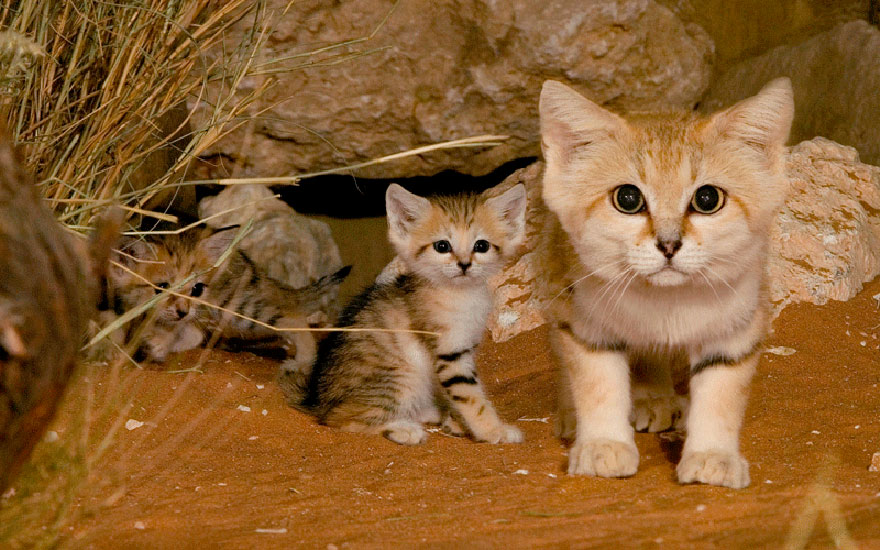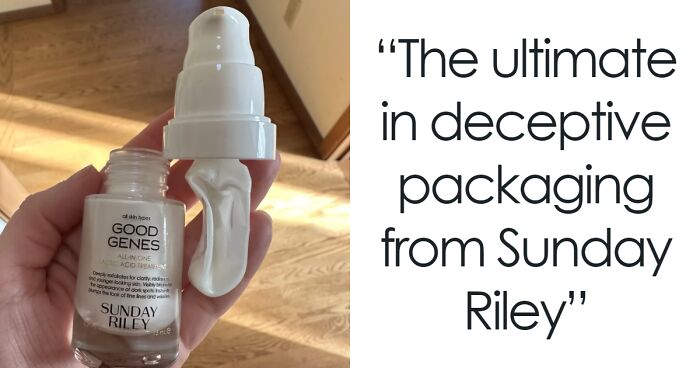
Sand Cats: Where The Adults Are Kittens And The Kittens Are Also Kittens
Sand cats are the Peter Pan of felines: they retain a kitten-like appearance their whole lives, giving the impression that they never grow up. Although they live in the desert Areas of North Africa, Arabia, Central Asia, and Pakistan, they are considered near threatened due to the illegal pet trade and sport hunting.
These cats are well adapted to their harsh environment. They can survive in temperatures between −5 °C (23 °F) to 52 °C (126 °F) and are able to survive for months on the water in their food. Unfortunately, a recent study indicated that only 61% of sand cats born in captivity live to day 30, primarily due to maternal neglect; they are also prone to various respiratory illnesses which makes them unsuitable as pets.
(h/t: thedodo)
Image credits: adremeaux
Image credits: John Jones
Image credits: home_77Pascale
Image credits: Big Cat Rescue
Image credits: goodnewsanimal
Image credits: Big Cat Rescue
Image credits: makhalifa
Image credits: surfingbird
Image credits: Ami211
Image credits: Tambako
Image credits: Mark Baldwin
Image credits: mellting
Image credits: Tambako
305Kviews
Share on Facebook"Unfortunately, a recent study indicated that only 61% of sand cats born in captivity live to day 30, primarily due to maternal neglect; they are also prone to various respiratory illnesses which makes them unsuitable as pets." Why is this unfortunately? I think it is great.. that way humans won't keep them as pets like that crazy fox lady does.. They belong in the wild and should do so. Not in cages in zoo's and with sick people that want a different kind of pet than the neighbor has..
It's unfortunate because captive breeding is one of the best hopes for continuing the species dumdum.
Load More Replies...There was an interesting article in National Geographic Magazine a few years ago about selective breeding to domesticate foxes in Russia. They documented what changes in appearance and behavior occurred with each generation. Domestication is not just behavior modification; it makes genetic changes. A truly domesticated animal is not the same as its wild cousin, just as a German shepherd is not the same as a wolf. Humans have domesticated many species for our own purposes, and I have no problem with that. But a wild animal rarely makes a good pet, and domestication does not preserve the original genome. Zoos try to maintain the original genetics, but a manmade environment does not teach survival skills and it's very tricky (though not impossible) to transition zoo-raised animals back to the wild. Ideally, we need to preserve the wild habitat and stop killing wild animals for stupid human reasons.
Right on Robyn. Why do comments have to always come down to name calling like children? That is SO FAR off the point of discussion. Opinions are great and interesting to read because there are so many of them. Let everyone have one and voice it without the added name calling, please. And by the way..They are such beautiful small creatures!!!
Load More Replies...SO cool...wonder if transplantation would work....the eastern Utah desert should be perfect for them, lots of little rodent, some water lots of cover for a small cat, they would learn how to thwart coyotes.....might be worth thinking about....
They're such interesting and beautiful members of the feline family! They just should not be in captivity. Neither should I! I well understand, and people should observe these fascinating creatures fro afar - and let them live.
With cats, its all about them domesticating us.... cats are cats are cats. Sounds like this little cat has some built-in breathing thing that helps them in their own environment but hurts them elsewhere - sad because this means they are vulnerable as their native habitat changes/disappears :( But guess what - inter species breeding (which DOES happen in the wild) has historically helped solve problems like that. Keeping such critters 'pure' is just as unnatural as humans breeding animals for certain characteristics... They are uber-cute LOL
Are you seriously suggesting genetic alteration, as opposed to say, restricting human indulging in their native habitat in order to allow them to thrive where they are? Human genetic manipulation, as with with Ligers(a ridiculous experiment IMO, seemingly for human interest/amusement). As to inter-species breeding in the wild, you’re referring to retroactive postulates about breeding over literally millions of years and even those can be proven with absolute certainty. Please stop stating it as if it’s some kind of frequent enough, successful phenomena resulting in vibrant offspring within a shorter periods of time. Too often humans fancy themselves as being capable of manipulating things that otherwise took a very long time, and who knows what else to occur. Seems more simple to recognize their habitats and do our best to work around them, allowing them to thrive as is.
Load More Replies...I hope these cute photo's won't make people try to domesticate them but help them to start breeding in the wils again.
don't forget that they are pound for pound one of the most ferocious creatures out there, and have been known to drink their prey's blood when all other sources of liquid are lost; they also enjoy hunting adders.
It crushes me to think that thanks to humanity's selfish needs and wants that this precious species is just about extinct. This is what rich people do, they take whatever they want with little or no thought as to how this will affect the animal or environment itself. Had i the money, i would try to enforce their area as a sanctuary, and post guards to ensure their safety. Unfortunately, i'm not so all i can do is cross my fingers and pray that this beautiful cat does not go extinct or that a foundation out there will take up the cause to protect them.
Super cute pics, thanks for sharing them! I'd never heard of these little dudes. Cute :)
What adorable animals; I can see why people want to keep them as pets. I am agnostic about whether they should be bred in captivity, but I do wonder what kind of pets they would make. What are their temperaments like? I wonder if they would take well to being "owned," or would be really wild in a house. In any case, I assume their thick coats serve as insulation against the heat, and their big ears help diffuse the heat and cool their blood. Am I right?
Why not just let a domesticated cat raise the kittens when they are born? Zoos and vets do that with other animals. As for the respiratory issues, cross breeding them with a domesticated cat like the Singapura, Devon Rex, or Burmese may help with the respiratory fragility of the cats - producing a new, more hardy, small breed of domestic felines.
These cats are very cute. To bad No one can own one. Can they ever be tame enough to touch?
no. they hunt and eat adders and other poisonous snakes for breakfast. much to feral to be tamed.
Load More Replies..."Unfortunately, a recent study indicated that only 61% of sand cats born in captivity live to day 30, primarily due to maternal neglect; they are also prone to various respiratory illnesses which makes them unsuitable as pets." Why is this unfortunately? I think it is great.. that way humans won't keep them as pets like that crazy fox lady does.. They belong in the wild and should do so. Not in cages in zoo's and with sick people that want a different kind of pet than the neighbor has..
It's unfortunate because captive breeding is one of the best hopes for continuing the species dumdum.
Load More Replies...There was an interesting article in National Geographic Magazine a few years ago about selective breeding to domesticate foxes in Russia. They documented what changes in appearance and behavior occurred with each generation. Domestication is not just behavior modification; it makes genetic changes. A truly domesticated animal is not the same as its wild cousin, just as a German shepherd is not the same as a wolf. Humans have domesticated many species for our own purposes, and I have no problem with that. But a wild animal rarely makes a good pet, and domestication does not preserve the original genome. Zoos try to maintain the original genetics, but a manmade environment does not teach survival skills and it's very tricky (though not impossible) to transition zoo-raised animals back to the wild. Ideally, we need to preserve the wild habitat and stop killing wild animals for stupid human reasons.
Right on Robyn. Why do comments have to always come down to name calling like children? That is SO FAR off the point of discussion. Opinions are great and interesting to read because there are so many of them. Let everyone have one and voice it without the added name calling, please. And by the way..They are such beautiful small creatures!!!
Load More Replies...SO cool...wonder if transplantation would work....the eastern Utah desert should be perfect for them, lots of little rodent, some water lots of cover for a small cat, they would learn how to thwart coyotes.....might be worth thinking about....
They're such interesting and beautiful members of the feline family! They just should not be in captivity. Neither should I! I well understand, and people should observe these fascinating creatures fro afar - and let them live.
With cats, its all about them domesticating us.... cats are cats are cats. Sounds like this little cat has some built-in breathing thing that helps them in their own environment but hurts them elsewhere - sad because this means they are vulnerable as their native habitat changes/disappears :( But guess what - inter species breeding (which DOES happen in the wild) has historically helped solve problems like that. Keeping such critters 'pure' is just as unnatural as humans breeding animals for certain characteristics... They are uber-cute LOL
Are you seriously suggesting genetic alteration, as opposed to say, restricting human indulging in their native habitat in order to allow them to thrive where they are? Human genetic manipulation, as with with Ligers(a ridiculous experiment IMO, seemingly for human interest/amusement). As to inter-species breeding in the wild, you’re referring to retroactive postulates about breeding over literally millions of years and even those can be proven with absolute certainty. Please stop stating it as if it’s some kind of frequent enough, successful phenomena resulting in vibrant offspring within a shorter periods of time. Too often humans fancy themselves as being capable of manipulating things that otherwise took a very long time, and who knows what else to occur. Seems more simple to recognize their habitats and do our best to work around them, allowing them to thrive as is.
Load More Replies...I hope these cute photo's won't make people try to domesticate them but help them to start breeding in the wils again.
don't forget that they are pound for pound one of the most ferocious creatures out there, and have been known to drink their prey's blood when all other sources of liquid are lost; they also enjoy hunting adders.
It crushes me to think that thanks to humanity's selfish needs and wants that this precious species is just about extinct. This is what rich people do, they take whatever they want with little or no thought as to how this will affect the animal or environment itself. Had i the money, i would try to enforce their area as a sanctuary, and post guards to ensure their safety. Unfortunately, i'm not so all i can do is cross my fingers and pray that this beautiful cat does not go extinct or that a foundation out there will take up the cause to protect them.
Super cute pics, thanks for sharing them! I'd never heard of these little dudes. Cute :)
What adorable animals; I can see why people want to keep them as pets. I am agnostic about whether they should be bred in captivity, but I do wonder what kind of pets they would make. What are their temperaments like? I wonder if they would take well to being "owned," or would be really wild in a house. In any case, I assume their thick coats serve as insulation against the heat, and their big ears help diffuse the heat and cool their blood. Am I right?
Why not just let a domesticated cat raise the kittens when they are born? Zoos and vets do that with other animals. As for the respiratory issues, cross breeding them with a domesticated cat like the Singapura, Devon Rex, or Burmese may help with the respiratory fragility of the cats - producing a new, more hardy, small breed of domestic felines.
These cats are very cute. To bad No one can own one. Can they ever be tame enough to touch?
no. they hunt and eat adders and other poisonous snakes for breakfast. much to feral to be tamed.
Load More Replies...
 Dark Mode
Dark Mode 

 No fees, cancel anytime
No fees, cancel anytime 








































176
44